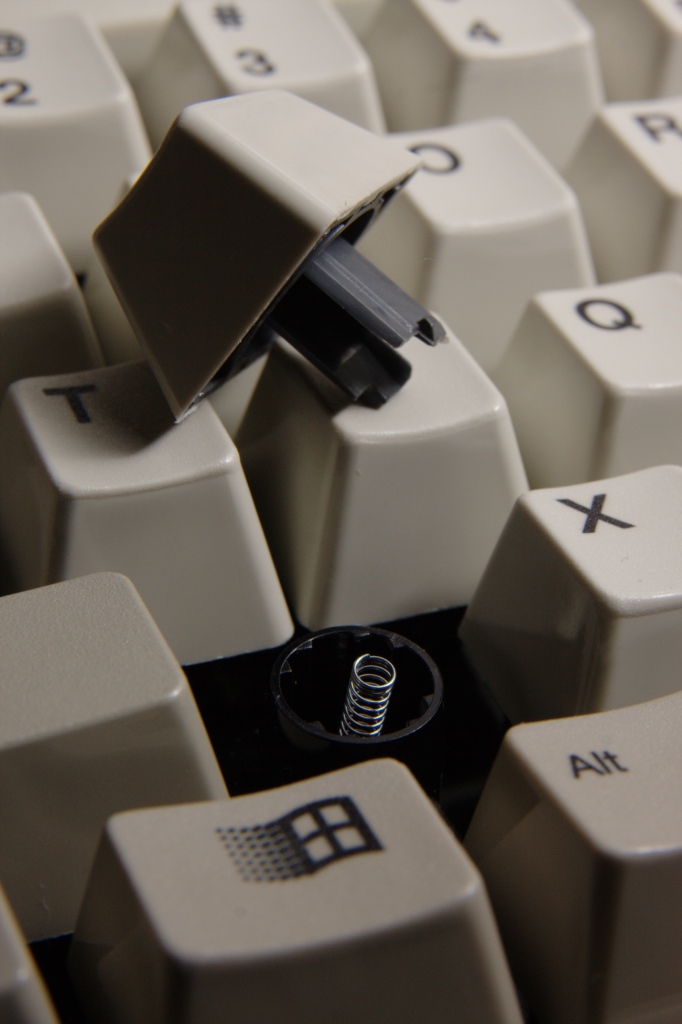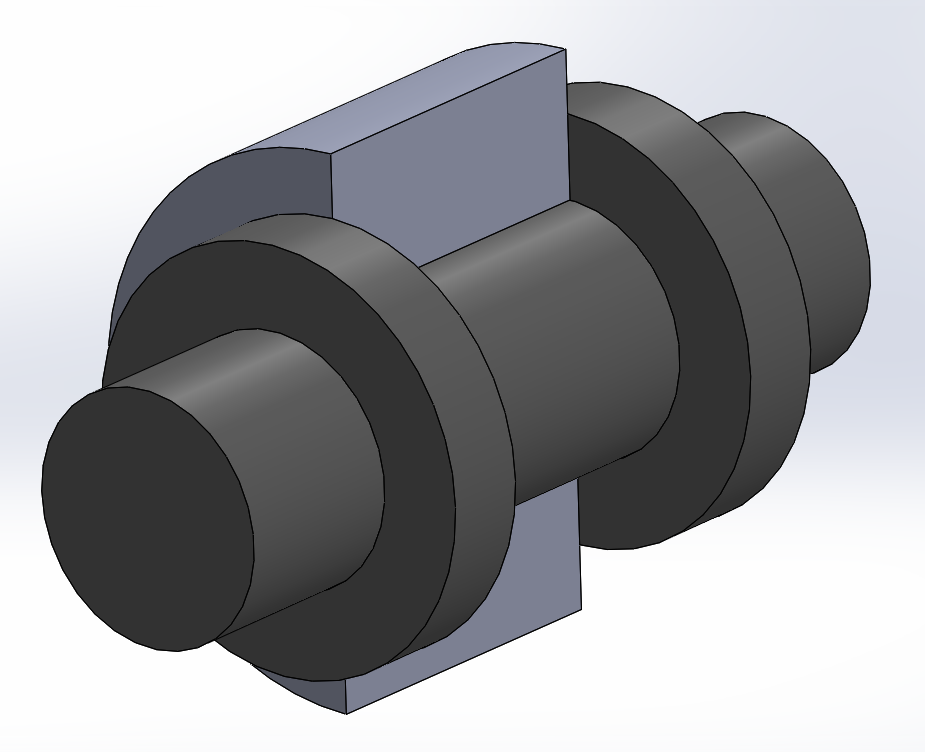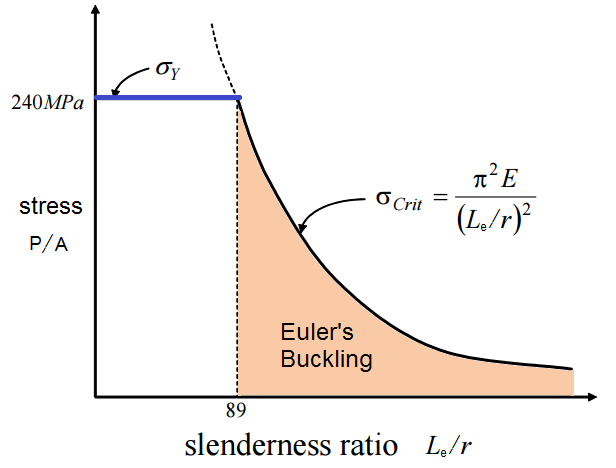|
Buckling Spring
A buckling spring is a type of keyswitch mechanism, popularized by IBM's keyboards for the PC, PC/AT, 5250/3270 terminals, PS/2, and other systems. It was used by IBM's Model F keyboards (for instance the AT keyboard), and the more common Model M. It is described in (Model F) and (Model M), both now expired. According to the original patent: "A non-teasible, snap action, tactile feedback, key mechanism of extreme mechanical simplicity and high reliability is achieved." Operation The coil spring tensed between the keycap and a pivoting hammer buckles (i.e. kinks or collapses) at a certain point in its downward traverse, providing auditory and tactile feedback to the keyboard operator. Upon buckling, the hammer is pivoted forward by the spring and strikes an electrical contact which registers the key press. In a Model M, the electrical contact is a membrane sheet similar to that of a modern dome switch keyboard. Image gallery File:Bucklingspring-animation-300ms.gif, Bu ... [...More Info...] [...Related Items...] OR: [Wikipedia] [Google] [Baidu] |
Unicomp Space Saver Model M
Unicomp GA LLC (formerly Unicomp, Inc.) is an American manufacturer of computer keyboards and keyboard accessories, based in Lexington, Kentucky. The company was founded in 1996 by ex-IBM and Lexmark employees. Unicomp is the current license holder and manufacturer of Model M keyboards using buckling spring key switches, the patents for which they purchased from Lexmark in 1996. History In 1996, Lexmark International was prepared to shut down their Lexington keyboard factory where they produced Model M buckling-spring keyboards. IBM, their principal customer and the ''Model Ms original designer and patent holder, had decided to remove the ''Model M'' from its product line in favor of cost-saving rubber-dome keyboards. Rather than seeing its production come to an end, a group of former Lexmark and IBM employees purchased the license, tooling and design rights for buckling-spring technology, and, in April 1996, reestablished the business as Unicomp. Since 1996, the tooling and m ... [...More Info...] [...Related Items...] OR: [Wikipedia] [Google] [Baidu] |
Mechanism (technology)
In engineering, a mechanism is a device that transforms input forces and movement into a desired set of output forces and movement. Mechanisms generally consist of moving components which may include Gears and gear trains; Belts and chain drives; cams and followers; Linkages; Friction devices, such as brakes or clutches; Structural components such as a frame, fasteners, bearings, springs, or lubricants; Various machine elements, such as splines, pins, or keys. German scientist Franz Reuleaux defines ''machine'' as "a combination of resistant bodies so arranged that by their means the mechanical forces of nature can be compelled to do work accompanied by certain determinate motion". In this context, his use of ''machine'' is generally interpreted to mean ''mechanism''. The combination of force and movement defines power, and a mechanism manages power to achieve a desired set of forces and movement. A mechanism is usually a piece of a larger process, known as a mech ... [...More Info...] [...Related Items...] OR: [Wikipedia] [Google] [Baidu] |
Keyboard Technology
The technology of computer keyboards includes many elements. Many different keyboard technologies have been developed for consumer demands and optimized for industrial applications. The standard full-size (100%) computer alphanumeric keyboard typically uses 101 to 105 keys; keyboards integrated in laptop computers are typically less comprehensive. Virtual keyboards, which are mostly accessed via a touchscreen interface, have no physical switches and provide artificial audio and haptic feedback instead. This variety of keyboard can prove useful, as it is not limited by the rigid nature of physical computer keyboards. The majority of modern keyboards include a control processor and indicator lights to provide feedback to the user (and to the central processor) about what state the keyboard is in. Plug-and-play technology means that its "out of the box" layout can be notified to the system, making the keyboard immediately ready to use without the need for further configuratio ... [...More Info...] [...Related Items...] OR: [Wikipedia] [Google] [Baidu] |
IBM PC
The IBM Personal Computer (model 5150, commonly known as the IBM PC) is the first microcomputer released in the List of IBM Personal Computer models, IBM PC model line and the basis for the IBM PC compatible ''de facto'' standard. Released on August 12, 1981, it was created by a team of engineers and designers at IBM, International Business Machines (IBM), directed by William C. Lowe and Philip Don Estridge in Boca Raton, Florida. Powered by an x86-architecture Intel 8088 processor, the machine was based on open architecture and third-party peripherals. Over time, expansion cards and software technology increased to support it. The PC had influence of the IBM PC on the personal computer market, a substantial influence on the personal computer market; the specifications of the IBM PC became one of the most popular computer design standards in the world. The only significant competition it faced from a non-compatible platform throughout the 1980s was from Apple Inc., Apple's Maci ... [...More Info...] [...Related Items...] OR: [Wikipedia] [Google] [Baidu] |
Model F Keyboard
The Model F was a series of computer keyboards produced mainly from 1981–1985 and in reduced volume until 1994 by IBM and later Lexmark. Its mechanical-key design consisted of a buckling spring over a capacitive Printed circuit board, PCB, similar to the later Model M keyboard that used a membrane in place of the PCB. The Model F first appeared with the IBM System/23 Datamaster all-in-one computer. It is best known as part of the IBM Personal Computer in 1981 with some keycap label differences, and its subsequent release with the IBM Personal Computer/AT, where it was reconfigured with the AT protocol and some layout revisions. After the introduction of the Model M keyboard, production was ramped down and eventually limited to replacement units for existing installations. The capacitive design is widely considered superior to that of the later membrane design used on the Model M. It has a lighter actuation force of about 600 Milli, mNewton_(unit), N, a crisper feel, and loud ... [...More Info...] [...Related Items...] OR: [Wikipedia] [Google] [Baidu] |
AT Keyboard
The Model F was a series of computer keyboards produced mainly from 1981–1985 and in reduced volume until 1994 by IBM and later Lexmark. Its mechanical-key design consisted of a buckling spring over a capacitive PCB, similar to the later Model M keyboard that used a membrane in place of the PCB. The Model F first appeared with the IBM System/23 Datamaster all-in-one computer. It is best known as part of the IBM Personal Computer in 1981 with some keycap label differences, and its subsequent release with the IBM Personal Computer/AT, where it was reconfigured with the AT protocol and some layout revisions. After the introduction of the Model M keyboard, production was ramped down and eventually limited to replacement units for existing installations. The capacitive design is widely considered superior to that of the later membrane design used on the Model M. It has a lighter actuation force of about 600 m N, a crisper feel, and louder feedback. It also has a higher MTBF ... [...More Info...] [...Related Items...] OR: [Wikipedia] [Google] [Baidu] |
Model M Keyboard
Model M keyboards are a group of computer keyboards designed and manufactured by IBM starting in 1985, and later by Lexmark International, Maxi Switch, and Unicomp. The keyboard's different variations have their own distinct characteristics, with the vast majority having a buckling-spring key design and uniform profile, swappable keycaps. Model M keyboards are notable among computer enthusiasts and frequent typists due to their durability, typing-feel consistency, and their tactile and auditory feedback. The popularity of the IBM PC and its successors made the Model M's design influential: Almost all later general-purpose computer keyboards mimicked its key layout and other aspects of its ergonomics. The layout was standardized by ISO in 1994 and ANSI in 1998, with minor additions—most notably the Windows key and Menu key. The Model M is regarded as a classic and durable piece of hardware. Although the computers and computer peripherals produced concurrently with them ... [...More Info...] [...Related Items...] OR: [Wikipedia] [Google] [Baidu] |
Coil Spring
A tension coil spring A coil spring is a mechanical device that typically is used to store energy and subsequently release it, to absorb shock, or to maintain a force between contacting surfaces. It is made of an elastic material formed into the shape of a helix that returns to its natural length when unloaded. Under tension or compression, the material (wire) of a coil spring undergoes torsion. The spring characteristics therefore depend on the shear modulus. A coil spring may also be used as a torsion spring: in this case the spring as a whole is subjected to torsion about its helical axis. The material of the spring is thereby subjected to a bending moment, either reducing or increasing the helical radius. In this mode, it is the Young's modulus of the material that determines the spring characteristics. Spring rate A selection of conical coil springs Spring rate is the measurement of how much load (in pounds) a coil spring can hold until it compresses . The spring r ... [...More Info...] [...Related Items...] OR: [Wikipedia] [Google] [Baidu] |
Keycap
A keycap is a small cover of plastic, metal, or other material placed over the keyswitch of a computer keyboard. Keycaps are often illustrated to indicate the key function or alphanumeric character they correspond to. Early keyboards were manufactured with the keyswitch and keycap integrated in ''one'' unit; keycaps ''separate'' from the switch were introduced to facilitate the production of different keyboard ''layout''s. History Typical keycaps in the 1970s and 1980s were produced using two-shot molding, with the markings molded into each keycap in a different color of plastic. This eventually fell out of favor, as it was more expensive (particularly in tooling costs), and tended to produce keycaps more durable than the equipment on which they were mounted. Modern keycaps are usually labelled by stamping or laser engraving. However, two-shot molding ("doubleshot") keycaps are still available today, known for their feel and general durability. Modern keycaps Keycaps c ... [...More Info...] [...Related Items...] OR: [Wikipedia] [Google] [Baidu] |
Buckling
In structural engineering, buckling is the sudden change in shape (Deformation (engineering), deformation) of a structural component under Structural load, load, such as the bowing of a column under Compression (physics), compression or the wrinkling of a plate under Shearing (physics), shear. If a structure is subjected to a gradually increasing load, when the load reaches a critical level, a member may suddenly change shape and the structure and component is said to have ''buckled''. Euler's critical load and Johnson's parabolic formula are used to determine the buckling stress of a column. Buckling may occur even though the Stress (mechanics), stresses that develop in the structure are well below those needed to cause Catastrophic failure, failure in the material of which the structure is composed. Further loading may cause significant and somewhat unpredictable deformations, possibly leading to complete loss of the member's load-carrying capacity. However, if the deformation ... [...More Info...] [...Related Items...] OR: [Wikipedia] [Google] [Baidu] |
Euler's Critical Load
Euler's critical load or Euler's buckling load is the compressive Structural load, load at which a slender column will suddenly bend or Buckling , buckle. It is given by the formula: P_ = \frac where *P_, Euler's critical load (longitudinal compression load on column), *E, Young's modulus of the column material, *I, minimum second moment of area of the cross section of the column (area moment of inertia), *L, unsupported length of column, *K, :File:ColumnEffectiveLength.png, column effective length factor This formula was derived in 1744 by the Switzerland, Swiss mathematician Leonhard Euler. The column will remain straight for loads less than the critical load. The ''critical load'' is the greatest load that will not cause lateral deflection (buckling). For loads greater than the critical load, the column will deflect laterally. The critical load puts the column in a state of Instability, unstable equilibrium. A load beyond the critical load causes the column to Structural inte ... [...More Info...] [...Related Items...] OR: [Wikipedia] [Google] [Baidu] |
List Of Mechanical Keyboards
Mechanical keyboards (or mechanical-switch keyboards) are computer keyboard A computer keyboard is a built-in or peripheral input device modeled after the typewriter keyboard which uses an arrangement of buttons or Push-button, keys to act as Mechanical keyboard, mechanical levers or Electronic switching system, electro ...s which have an individual switch for each key. The following table is a compilation list of mechanical keyboard models, brands, and series: Mechanical keyboards References {{Reflist Computer keyboards Mechanical keyboards ... [...More Info...] [...Related Items...] OR: [Wikipedia] [Google] [Baidu] |








